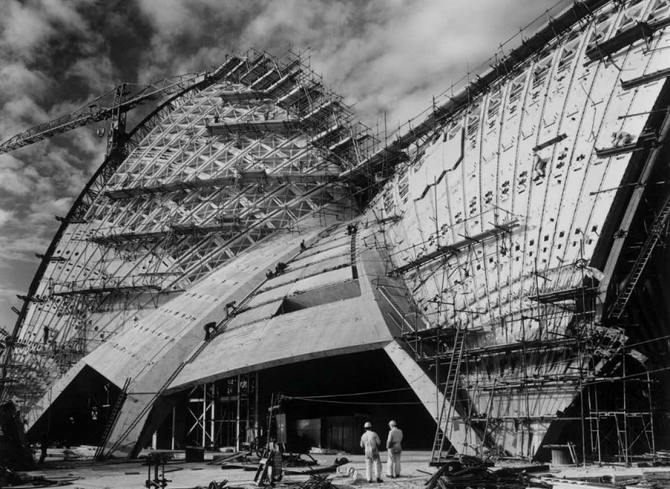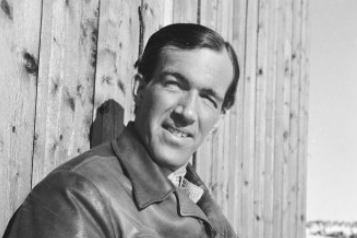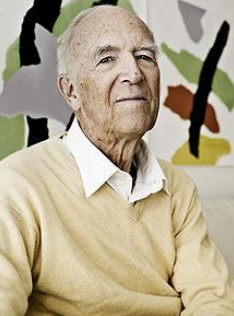
Travel today is universal. Everyone travels. It is said to broaden the mind and expand one’s horizons. It is also education, education of the very best kind. Little has been written about the importance of travel for architects. It is a little-discussed subject, especially as it relates to the developing sensibility of young architects. Music, painting and poetry can be studied anywhere—architecture is different. To properly appreciate a great building you must walk around and inside it, look at it up close, visit at all hours of the day, as Goethe did at Strasbourg cathedral, and see it in all lights. And, most important of all, study it in its surroundings. Direct observation should be supplemented by reading as a preliminary to fully appreciate it as art and understand its history. Only then is the observer best able to experience and reflect on the aesthetic, what it says about its time and place in history.
A recent Danish exhibition, Horizont (horizon) mounted by the Utzon Centre in Aalborg at the Sydney Opera House, to celebrate the centenary of Jørn Utzon’s birth, documented his early travels in Morocco in 1947 and America in 1949. Utzon was an extremely private man, and it is only recently that the family archives have become available for scrutiny by scholars. The exhibition dealt with a crucial, though largely unknown period after the end of the Second World War, when Danes could again travel. Many, including Utzon, visited Paris to immerse themselves in the new wave of intellectual ideas and art and escape the grey suffocation imposed by the German occupation. Utzon was more adventurous than many. His breakout took him further, and was crucial in setting the direction for his later development. His encounters with other very different cultures profoundly shaped his outlook and creative commitments, taking him well beyond the limited orbit of Scandinavia. He met Frank Lloyd Wright and Eero Saarinen, tramped over Mayan temple complexes in the humid jungles of the Yucatan Peninsula, and explored the vernacular villages of the Atlas Mountains. This would transform him, and a decade later, propel him from an isolated studio in a beech forest on the north coast of Zealand, to world fame overnight on winning the National Opera House competition in 1957.
This essay appeared in a recent Quadrant.
Click here to subscribe
The end of the war liberated Danes intellectually and sparked a new exciting period of creative change under the Marshall Plan. Paris beckoned: Existentialism, Jean-Paul Sartre and Simone de Beauvoir were making headlines; art galleries were freed of Nazi censorship, Picasso and Le Corbusier emerged from the shadows. In tiny Denmark, travel released artists from Danish insularity. Utzon jumped at the opportunity to visit Paris and meet the Swiss-born Modernist, Le Corbusier. Paris was just a beginning—North Africa and America beckoned.
In the Yucatan, Arizona and Morocco, Utzon discovered what he would later call “Living Architecture”. When sculpture supports architecture and augments its expressive power, when the two work as one, as in the Mayan temple complexes, something remarkable occurs—architecture is infused with sculptural vitality. It almost seems to come alive. In addition, Mayan platforms helped Utzon find a means to unite architecture and landscape. Instead of being an intruder, something separate, buildings merge with landscape. Utzon stumbled on a device that eliminated the dualism which divorced buildings from their surroundings. That device was the stepped platform.
Utzon did not reject his Scandinavian roots, but his travels enlarged his vision and opened it up to new possibilities. The Finnish master Alvar Aalto had been a strong early influence, although Utzon’s contact was limited to a six-week stay in Aalto’s Helsinki studio. Aalto’s father was a land surveyor. Surveyors record the disposition and shape of land, they take levels and map its contours. Contours guided Aalto’s placement of buildings; he would extend the formal architectural geometry outwards by means of angular terraces that echo the organic architectural order of his buildings from their immediate landscape by a similar shared geometry. Instead of making his buildings spill outwards as Aalto did, Utzon reversed the movement and pulled the terrain inwards, much as we do when we go to bed and draw the coverlet over us. His platforms create a new terrain, in effect a new artificial earth that converted his buildings into a stepped terrain that draws in and echoes their immediate surroundings, something like the hillside rice-paddy terraces of Bali and theatres in Greece and Incan Peru.
Buildings melt into the landform and become implicit extensions of terrain, a terrain architecture, obviously manmade and shaped to serve human requirements, nevertheless, one that is no longer outside nature. The era of National Romanticism, Scandinavia’s version of German Romanticism, was largely over when Utzon began but some residual element, a certain feeling for form and closeness to nature, can be detected in his design.
 In the 1950s, Super8 movie cameras placed film-making in the hands of middle-class amateurs. Many family men like Utzon were fascinated by the new equipment. The lightweight portable camera enabled architects to capture the experience as they walked around, moved in close, filmed inside and explored the spaces in each building. Although the footage was inferior in quality to 35mm colour transparency film, the Super8 footage still captured the experience over time from multiple viewpoints. It turned Utzon — pictured at right in those days — into a budding film director, perhaps not a master like Ingmar Bergman, but it was exhilarating and addictive.
In the 1950s, Super8 movie cameras placed film-making in the hands of middle-class amateurs. Many family men like Utzon were fascinated by the new equipment. The lightweight portable camera enabled architects to capture the experience as they walked around, moved in close, filmed inside and explored the spaces in each building. Although the footage was inferior in quality to 35mm colour transparency film, the Super8 footage still captured the experience over time from multiple viewpoints. It turned Utzon — pictured at right in those days — into a budding film director, perhaps not a master like Ingmar Bergman, but it was exhilarating and addictive.
Art is about new ways of seeing. The Renaissance discovery of perspective changed not only painting, it caused a new visual culture, which, in turn, led to a new conception of space. Perspective set up the single viewpoint and ordered Renaissance pictorial space. Cubism at the beginning of the twentieth century changed that. In 1941, the Swiss historian Sigfried Giedion titled his Norton Lecture series on modern architecture Space, Time and Architecture. He did so to focus attention on the unifying centrality of the new space-time concept. In this context, Utzon’s amateur film-making activity assumes a special importance as a practical response that directly addressed the new space as experiential and phenomenal. Seeing space serially in time, from multiple viewpoints, revolutionised twentieth-century space. We look at paintings frontally, but the experience of architecture is far more complex, more demanding and difficult. Cubism had explored this, and the movie camera now captured space as dynamic and unfolding. Today’s video camera and smartphones have replaced the primitive Super8 camera and made it film-making commonplace.
What exactly did Utzon find in the jungles of Yucatan? His diary is informative. On his visit to the Palace of the Governor at Uxmal, Utzon was confronted by an extraordinary sculpture:
What mainly sets Uxmal apart from other structures I have seen was the rich, almost extravagant detailing; almost every stone was sculpted with animal motifs such as snakes, birds, toads, turtles, either once or as a repeated pattern to form borders or cornices, while richly ornamented human beings, half in relief, or in some places, for instance, in the corners, almost completely carved out, almost as free-standing sculptures, were taking up the space in the middle. One of the most profound ornaments was a snake motif, where all the stones in the snake’s body were the same, however, because of the intricate interlocking system, it was possible to turn these joints in different directions, making the snake twist on the surface that was 5m tall and 30–40m long while still remaining interlocked with the rest of the stonework. This is the best example I have ever seen, where one can really say what is architecture and what is sculpture because everything is working together to create a sense of the whole.
Only when it is linked to sculpture does “Living Architecture” make sense. Only then do we begin to understand Utzon’s intention in the Sydney Opera House. Sculpture, certainly traditional sculpture, enlivens a building, makes it writhe and wriggle like an Uxmal snake. This is such a far cry, so profoundly different from the idea of a mechanical Modernism. It linked architecture to sculpture as a unity. It initiated a profound shift away from functional Modernism towards expression by injecting a primitive animism into the machine architecture of the twentieth century. The shift not only enlivened but served to humanise it.
The feature of the Sydney Opera House where this idea is most successful is the tile roofs. Utzon developed two finishes for the tiles: a glazed and a rough matt tile consisting of a mixture of crushed tile fragments to break up its surface and disperse the reflected sunlight. The glazed tile is used everywhere, the rough matt tile introduced as an edge border outlining the fish-scale-shaped tile panels. The effect is comparable to the interlocking stones of the Uxmal snake. Through the day, as clouds drift across the sky and the elevation and angle of the sun changes, the appearance of the tiles changes—the tiles reflect the day and impart an ever-changing living quality to the roof vaults.
Utzon praised the Mayan practice of building their temples on top of massive platforms. The platform is by no means unique to Central America—it can be found in ancient Chinese, Greek, and even Polynesian temples. Utzon adopted the platform for a somewhat different reason: not to separate, but to unite his buildings with landscape. There was a further practical consideration which separated pedestrians from motor vehicles: pedestrians move up monumental stairs, leaving the ground plane free for motor vehicles.
Morocco is the source of Utzon’s second concept: additive group form. When he visited the mudbrick hill villages of the foothills of the Atlas Mountains he discovered their siting was not regulated as in the West, instead each builder related each building to its neighbours. Utzon was fascinated by how this resulted in a unified overall form, and how well each house was related to its neighbour and created a harmonious totality:
All the houses were the same colour as the ground we stood on, yet they were full of subtle shades. And when they were building—they were almost always working on something somewhere—they sang. Always in rhythm with the way in which they stamped the clay in oblong moulds—almost three or four metres long and about seventy-five centimetres high. Always accompanied by singing. Every house was so beautifully placed quite unlike the conformity of houses in Denmark and Sweden. Here the buildings are placed in relation to each other and in relation to the undulations of the terrain. I was profoundly inspired by the way of building in natural surroundings.
The Kingohusens Housing Estate, at Helsingør (Elsinor) 1957–59, and Fredensborg for the Danish Co-operative Building Company, 1962–63, are obvious instances that benefited from the Atlas examples. At Helsingør the courtyard houses circle around a small lake at the centre; at Fredensborg they combine in a long chain that loops up and down on either side of the hillside. Whereas the houses at Helsingør climax in a lake, at Fredensbørg they culminate in the meeting house which at Uxmal is the head of the snake.
Utzon discovered his direction in his thirties, and went on refining it, project by project. In his treatment of the Mayan platform as an extended architectural terrain Utzon was enabled to unify architecture with landscape, while the idea of “Living Architecture” led him to approach architecture as strong sculpture, the result of which is a unity we call a monument, an ambiguous word that may sometimes mean architecture and at other times sculpture. Utzon’s explanation of the Opera House, as something to be seen from above, from all round, is the same as a sculptor’s—he might be Henry Moore speaking. The art of sculpture is more difficult than painting, as the artist must satisfy not one frontal viewpoint but many. Thus it humanises Modern architecture and sets it on a path beyond the functional efficiency of the machine. “Additive architecture,” was Utzon’s response to standardisation; it gave him a procedure for combining multiple standard elements, his “kit of parts” notion of a flexible sculptural solution to standardisation founded on the lessons of vernacular building.
 In 1965 Sigfried Giedion selected Utzon to represent a new grouping of rising architects he called “The Third Generation”. It showed how highly Giedion considered Utzon’s contribution to future architecture in the West. Giedion stressed the importance of technology in shaping culture as revolving around not only new technology, but as requiring a rapprochement with the ancient past, allowing the Modern movement to assimilate its lessons on sculpture and symbolism, in order to negotiate the challenge posed by new technology.
In 1965 Sigfried Giedion selected Utzon to represent a new grouping of rising architects he called “The Third Generation”. It showed how highly Giedion considered Utzon’s contribution to future architecture in the West. Giedion stressed the importance of technology in shaping culture as revolving around not only new technology, but as requiring a rapprochement with the ancient past, allowing the Modern movement to assimilate its lessons on sculpture and symbolism, in order to negotiate the challenge posed by new technology.
Unlike Arne Jacobsen, Denmark’s pioneer Modernist, Utzon was inspired by encounters beyond Denmark and Scandinavia. His architecture is eclectic, mixing ideas and themes from contrasting and unrelated civilisations, though the result is a complex, profoundly Danish fusion which saw architecture primarily as sculpture. Vernacular buildings supplied new insights and models on how architecture might engage with nature and simultaneously engage with industrialised building through such ideas as his “kit of parts” and “additive architecture”.
Utzon’s open, warm personality, his enthusiasm and ability to communicate with others, what is popularly called charisma, gave him an uncanny capacity to take in, absorb and synthesise insights from earlier civilisations to help him to overcome the overwhelming dullness and banality of global industrial architecture. Aalto may have set Utzon’s direction, but Utzon — pictured above shortly before his death — , through an adventurous spirit and intense curiosity, found his own way.
Philip Drew, who lives in Sydney, is a frequent contributor on architecture.
 Sign In
Sign In 0 Items (
0 Items ( Search
Search










Thanks. Very illuminating. The Opera House is just as you describe – a beautiful building that fits in with the natural surroundings of the Harbour and the Botanic Gardens.It is a fitting building to replace that old tram shed. I saw it from a ferry recently and some of the tiles need a bit of steam cleaning, I suspect. It complements the grandeur of the Harbour Bridge.
Philip Drew’s paean to Utzon is troubling on so many levels!
How to start?
The nub of my concern springs from a brief encounter with a tutor in my studio group when I was studying architecture. After a particularly long ‘crit’ session (when students talk about their inchoate designs) our tutor wondered why none of us talked about people in relation to our schemes. My unspoken rebuttal — I was a mere lad — was ‘maybe because you blokes never talk about people in your lectures’.
Drew continues this architectural tradition of regarding the design of buildings as having no real existential human concern.
So for him, ‘most important (sic) of all, study [the great building] in its surroundings…’ No! Most important of all, know the purpose of the building in all its social aspects; study the way the building is regarded by the people who use it, pass by it, paid for it, approved it, and are sheltered, affronted, comforted or repelled by it.
The great irony of his reference to Utzon’s “Living Architecture” is that it seems to have little to do with life: that is, the social congress of humanity but reduces it to mere sculpture. Are buildings nothing but walk-in sculptures, with the only reference being aesthetic? I doubt it. But is seems that architects are too much locked into the de-personalised, socially agnostic approach to buildings as manifestations of drawing board art. Forget people, it would seem.
This comes to its horrifying full pitch in Utzon’s finding inspiration in Mesoamerican temples, placed in their ‘fusion of sculpture and architecture’ on magnificent plinths. Forget the social purpose of these temples: that they were built for human butchery, the settings for the horror-spectacle of innumerable human sacrifices, where the blood of murdered captives, hearts torn out of their chests, flowed. This is what this great inhuman fusion was for. And Drew would represent it to us as ‘Living Architecture’?
I’d prefer to reflect on an architecture that took as its point of contact the purposes, needs and interests of the people using and moving around the building, not some abstraction based on ritualised slaughter. Architecture is not drawing board art, but socially meaningful shelter in all its dimensions and not merely the aesthetic.